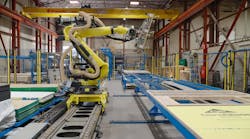The milestone of atmospheric carbon dioxide (CO2) levels rising above 400 ppm for the first time in 3 million years passed relatively quietly last month. The issue is so politicized that it is difficult for those with some knowledge and interest in the issue to determine exactly what this means. But our industry and community can certainly agree that this event demands some attention and that the current trend will more likely than not carry significant consequences. Certainly over the next few years, we will know much more about how consequential these changes to our atmosphere will be.
One of the most soft-pedaled of policies from the U.S. Department of Energy (DOE) is that of reducing building-energy use in the United States by 50 percent below 2004 levels by 2030. That is a very ambitious goal, but it’s do-able and would even be beneficial since it really just requires cleaning up the waste in building energy use. Because buildings consume 40 percent of total energy use in the United States, it is a very prudent environmental step that could create large numbers of jobs while ensuring our nation’s energy independence. But will it happen? Not a chance — at least not without significant change in the current policy and/or our industry business practices, all of which seem to be aimed at cutting first costs to make building efficiency retrofits more economically attractive. Such policy and practice is naïve at best.
Building owners are already reluctant to invest in energy-efficiency improvements. The simple reason is that the performance drift for typical buildings is of such magnitude that many such retrofits lose nearly all their savings benefits after just a few years. So just reducing the first cost of energy retrofits is not likely to energize building owners, and it most certainly will not achieve the policy goal.
What is needed is new thinking. And since it is not coming from outside, let’s try some ourselves. Here’s a thought to start us going: What is needed is a system of building-performance targets, along with periodic indicators to tell building owners how their buildings are doing. The Energy Star rating program is a reasonable start. Take the kBtu-per-square-foot result from the Energy Star rating (instead of the rather meaningless comparison rating) and compare that number with the 2004 Commercial Building Energy Consumption Survey (CBECS) average for that building type and climate. This makes it easy for the building owner to see how much energy-use reduction is needed to meet the 2030 target.
Now, let’s imagine you are an engineering or contracting firm looking to build a long-term relationship to provide your services in a particular building. If it doesn’t already have a recent Energy Star rating, you can have one of your new hires help get one and then use that as the focus of your initial owner’s meeting. Use it to show how much energy use needs to be reduced over the next 17 years (the number of years until 2030) to meet the US building energy use mandate. Explain that meeting this mandate is more than being a good citizen; there are likely to be much higher utility rates and perhaps penalties assessed for not doing so (which is likely as the understanding of CO2 and its relationship with climate change increases). Explain that there are returns on the investments required, and, no matter how utility bills are paid, there are models to capture those savings for the owner. Explain that this is the time to get started to bring their building up to par. And most important, explain — and be ready to execute — your program to ensure the projects you implement will not be subject to performance drift. That is what will differentiate your firm: You will work year-by-year (or even month-by-month) to ensure the designed savings from each project are maintained over time.
The changes required are not rocket science: LED lighting and high-efficiency equipment all tied together with effective, occupant-based controls that are often discussed but rarely implemented. For some smaller and older buildings there will be some envelope measures required as well. Consider that there are about 5 million commercial buildings in the United States. Our industry has to sign up more than a thousand new buildings every day until 2030 to succeed. So there is no dearth of potential customers. Nearly all of us working in the industry have a good idea what is necessary to succeed. The reason we do not succeed is we never have the level of control necessary. But if the owner knows we are committed to the building’s long-term performance, we’re more likely to gain that control. And if climate issues do become more apparent and United States building-efficiency policy becomes more strident, your business model will grow along with it. I encourage industry firms to think, discuss, develop, and start marketing such business plans. It is very likely) the wave of the future.
I invite your thoughts, comments, and good ideas about this article. Please log in or register below to make a public comment on the HPAC Engineering Website, or contact me directly at [email protected]











